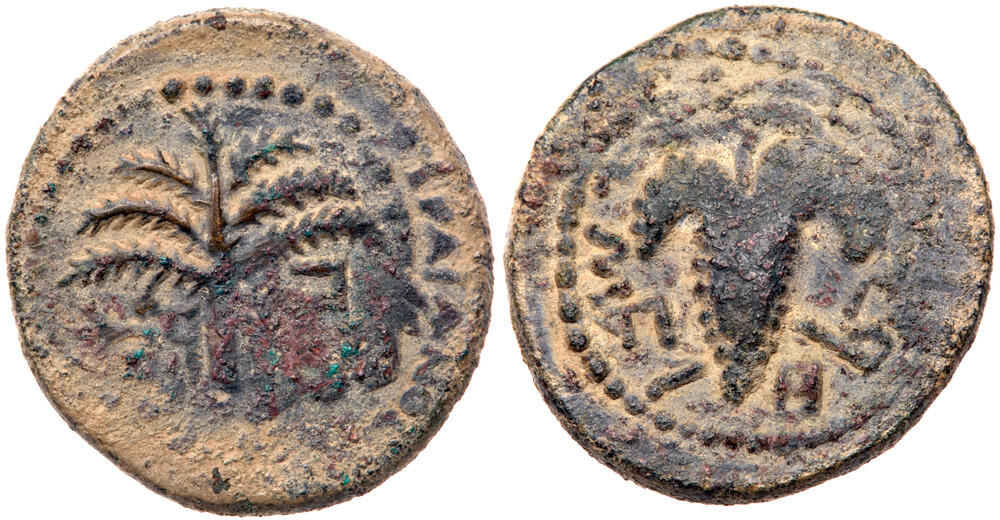Judaea (uncertain mint) (Bar Kokhba), small bronze (vine leaf/palm tree) (132-133 CE)
From SILVER
132 CE - 134 CE Bronze
Description
| ObverseInscription or printing placed on the obverse.: | 'Jerusalem' (Paleo-Hebrew).Seven-branched palm tree with two bunches of dates |
| ReverseInscription or printing placed on the reverse.: | 'Year two of the redemption of Israel' (Paleo-Hebrew).Bunch of grapes with branch and small leaf |
Mint and issuing power
| MintIdentifies the place of manufacture or issue of a numismatic object.: | Judaea (uncertain mint) | Ancient regionAncient region.: | Judaea | Modern countryModern country: Israel | AuthorityIdentifies the issuing power. The authority can be "pretended" when the name or the portrait of X is on the coin but he/she was not the issuing power. It can also be "uncertain" when there is no mention of X on the coin but he/she was the issuing power according to the historical sources: | Simon bar Kokhba (military leader and king of Judea, 132-135 CE) |
Chronology
| FromIdentifies the initial date in a range assigned in a numismatic context. | 132 CE | toIdentifies the final date in a range assigned in a numismatic context.. | 134 CE | PeriodTime period of the numismatic object.: Roman from 30 BC |
Physical description
| MetalThe physical material (usually metal) from which an object is made.: | Bronze |
Median weightMedian of the weights of numismatic objects (in grams). in grams | 6.00 | DenominationTerm indicating the value of a numismatic object. Examples: tetradrachm, chalkous, denarius.: | StandardStandard.: |
Image

Bar Kokhba small bronze.jpg [1]
References
| Die study referencePublication of the study: | Mildenberg 19841Mildenberg 1984, p. 327-333, n° 147-160 | ||
| Coin series referenceReference to coin series study: | |||
Obverse dies distribution
| FrequencyFrequency of specimen in distribution. ᵖ | Number of obversesNumber of obverse dies. ᵖ (o) | % (o) | Number of coinsNumber of coins. (n) | % (n) | Die nameName(s) of the die(s). |
| 25 | 1 | 25 | 25 | 14.71 | 2 |
| 31 | 1 | 25 | 31 | 18.24 | 3 |
| 53 | 1 | 25 | 53 | 31.18 | 4 |
| 61 | 1 | 25 | 61 | 35.88 | 1 |
| Total | 4 of 4 | 100 | 170 of 170 | 100.01 |
Reverse dies distribution
no distribution is available
Quantification
| Number of obversesNumber of obverse dies. ᵖ (o) | 4 | Number of singletons (o1)The number of singleton coins. ᵖ | 0 |
| Number of reverse diesNumber of reverse dies. (r) | 10 | Number of coinsNumber of coins. (n) | 170 |
| Coins per obverse dieNumber of coins per obverse die. (n/o) | 42.5 | Coins per reverse dieNumber of coins per reverse die. (n/r) | 17 |
| Reverse per obverse ratioRatio of obverse dies divided by reverse dies. (r/o) | 2.5 | Percentage of singletons (o1)number of coins (n) divided by the number of singletons (o1) ᵖ | 0 % |
| Original number of dies (O) (Carter 1983 formula)The estimation of the number of coins according to Carter 1983 ᵖ | 3.81 | Coins struck if 20,000 as average productivity per dieCoins made if the average productivity for obverses (according to Carter) is 20,000. ᵖ | 76,200 |
| Original number of dies (O) (Esty 2011 formula)The estimation of the number of coins according to the singleton formula in Esty 2011 ᵖ (O) | 4.1 | Survival rate if 20,000 as average productivity per dieSurvival rate if average productivity is 20,000. ᵖ | 0.00223 |
| Coverage (o = % of O) (Esty 1984 formula)Esty 1984 - coverage (% of O) ᵖ (o = % of O) | 100% | Die productivity if survival rate 1/2,000Average productivity if survival rate is 1/2,000. ᵖ | 89,238.85 |
| Weight of silver (in kg) if 20,000 coins per die (O = Carter formula)Carter 1983 * Median weight * 20000 (*10 if gold or electrum) ᵖ | n.a. | Die productivity if survival rate 1/5,000Average productivity if survival rate is 1/5,000. ᵖ | 223,097.11 |
Remarks
Most likely one single workstation Likely military